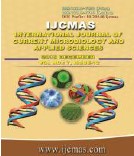


 National Academy of Agricultural Sciences (NAAS)
National Academy of Agricultural Sciences (NAAS)

|
PRINT ISSN : 2319-7692
Online ISSN : 2319-7706 Issues : 12 per year Publisher : Excellent Publishers Email : editorijcmas@gmail.com / submit@ijcmas.com Editor-in-chief: Dr.M.Prakash Index Copernicus ICV 2018: 95.39 NAAS RATING 2020: 5.38 |
Effect of eight antagonists viz., Trichoderma atroviride, T. harzianum, T. virens, T. fasciculatum, T. asperellum, T. viride, Pseudomonas fluorescens and Bacillus subtilis were studied for their antagonism against Macrophomina phaseolina by dual culture method and six fungicides viz. Azoxystrobin 23 SC, Carbendazim (12%) + Mancozeb (63%) 75 WP, Carbendazim (25%) + Mancozeb (50%) 75 WS were evaluated at two different concentrations (500 ppm and 1000 ppm) by poisoned food technique against the same pathogen. Out of eight antagonists evaluated, Trichoderma atroviride showed strong antagonistic effect against the pathogen with highest growth inhibition (60.00%) and among the six fungicides, carbendazim (12%) + mancozeb (63%), carboxin (37.5%) + thiram (37.5%), carbendazim (25%) + mancozeb (50%) and carbendazim were proved to be effective with cent per cent growth inhibition of the pathogen at both the concentrations (500 and 1000 ppm) tested. The effective biocontrol agents and chemicals which were found promising under laboratory studies were further evaluated for the management of stem and root rot of sesame under pot conditions. The highest germination (100%), higher shoot (17.06 cm) and root (4.03 cm) length, vigour index (2032) and minimum plant mortality (8.22%) was achieved through treatment T4 i.e. seed treatment with T. harzianum (2×108cfu/g) AAU isolate @ 10 g/ kg seeds + soil application of T. harzianum (2×108cfu/g) enriched FYM @ 100g/pot.
 |
 |
 |
 |
 |